Euphorbia schoenlandii
Euphorbia schoenlandii Pax
Family: Euphorbiaceae
Common names: compass barrelwort (Eng.), noordpol (Afr.).
Introduction
A distinctive succulent plant known for positioning itself so that the apex of its stem points northwards, towards the sun, that is endemic to the Succulent Karoo in the Western Cape Province of South Africa.
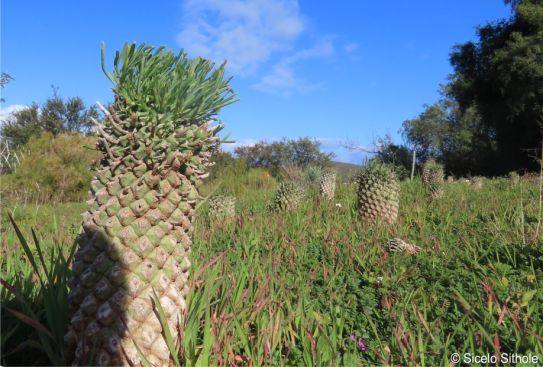
Description
Description
Euphorbia schoenlandii is a succulent plant that grows up to 0.5 m high. The main stem is erect, single or very unusually branched, up to 200 mm thick, cylindrical, covered with large, cone-shaped tubercles that are spirally arranged. The tubercles are up to 12 mm long, prominent, with a short, deflexed point at the tip, and a triangular depression or cavity on the upper slope just below the tip. Spines are modified sterile peduncles, solitary, up to 50 mm long and 5 mm thick, incurved-erect or spreading, straight or variably curved, rigid, woody.
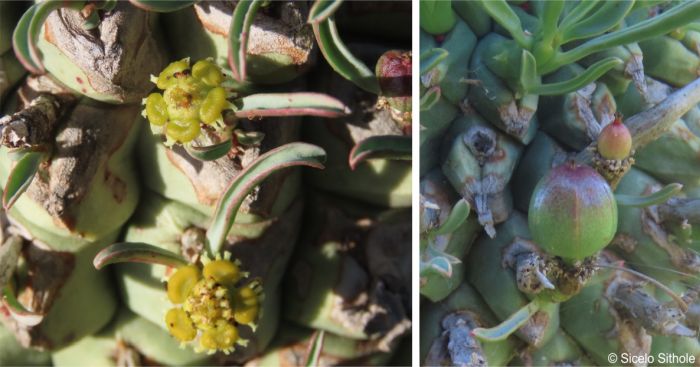
The inflorescences, termed cyathia, are solitary or in cymes of three, and many are produced towards the apex of the stem in autumn and early winter (April to June). The peduncles are short, only up to 25 mm long, bearing few bracts. The involucre is cup-shaped, 8 mm in diameter, with 5 glands, the inner margin with 3-8 smooth or 2-lobed straight processes, inner part of the gland is green, the outer rim yellow, and the processes white. Capsules are subsessile, shiny green and red.
Euphorbia schoenlandii is similar to both E. fasciculata and E. restituta, but both these species do not have sharp woody spines and their cyathia are on long peduncles.
Conservation Status
Status
The Red List of South African plants currently classifies Euphorbia schoenlandii as Vulnerable (VU). This species is at risk due to irregular but continuing habitat loss caused by the spread of vineyards and wheat farming in its distribution range. Moreover, the current assessment was made in 2007 and the recent increase in the illegal collection of wild plants for the horticultural market poses a serious threat to the survival of this species in its natural habitat, and as a result, it may soon be reclassified to a higher threat category.
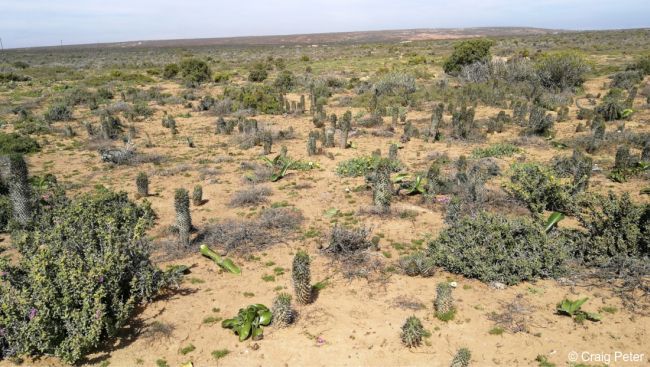
Distribution and habitat
Distribution description
Euphorbia schoenlandii has a restricted distribution in the Western Cape province of South Africa where it is found in Namaqualand Strandveld, Vanrhynsdorp Gannabosveld and Knersvlakte Quartz Vygieveld between Strandfontein and Vanrhynsdorp. Plants are found in open areas with deep, red aeolian sands, but also in loamy soil on the lower slopes of hills, where they often occur in fairly dense vegetation. The climate is a mild rainy winter and a hot dry summer.
Derivation of name and historical aspects
History
The genus Euphorbia is named after Euphorbus, who was a doctor to King Juba II of Mauretania in ancient North Africa. Euphorbus is believed to have extracted an effective laxative from the cactus-like euphorbias, which led King Juba to name this group of plants after his doctor. Carl Linnaeus gave the name Euphorbia to the whole genus in 1753. Nevertheless, the name consists of two Greek words, eu which means ‘well’ and pherbo which means ‘feed’, ‘nourish’ or ‘fat’. The common name for many euphorbias is spurge, which comes from Middle English and means ‘to purge’ due to the sap of most species being laxative. This species is named after Selmar Schönland (1860-1940), founder of the botany department at Rhodes University in Makhanda (formerly Grahamstown).
The family Euphorbiaceae consists of over 300 genera and 8 000 species. It is considered one of the largest dicot families occurring throughout tropical zones. The milky latex is one of the diagnostic characteristics of the family Euphorbiaceae. It has a strong, acrid smell and may lead to allergic reactions, blistering and even blindness if the latex reaches the eyes. If latex gets into the eyes, ample of water should be applied to rinse it off, and medical assistance sought if needed. The latex of some euphorbias releases a scentless, volatile compound which can cause extreme irritation, even in the absence of direct contact. Euphorbias have diverse habits, some are thorny, fleshy shrubs, others are large trees with candelabriform branching while others have slender pencil-thick stems growing in tufts.
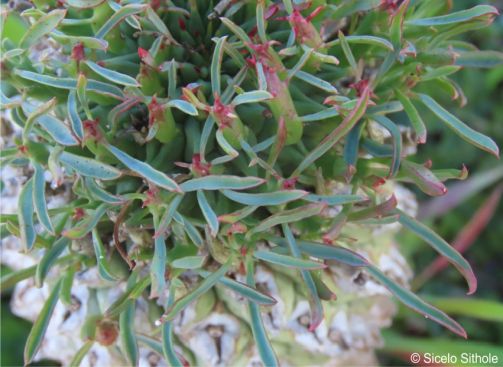
Ecology
Ecology
Individuals within the family Euphorbiaceae have a wide range of pollination systems and pollinator species due to the diversity of their flowers and inflorescences. Ants are the most frequently seen visitors to the cyathia of E. schoenlandii. Floral visitors included Karoo balbyter ants, small hairy sugar ants, tachinid flies, tumbling flower beetles, tube-tailed thrips and weevils. Plants in arid environments that have flowers with accessible nectaries, and because they are usually positioned close to the ground, tend to receive more visits by ants and are pollinated by ants.
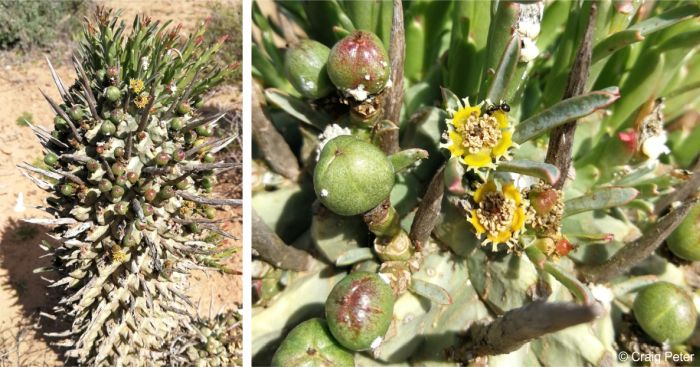
Uses
Use
Euphorbia schoenlandii and all succulent euphorbias make excellent houseplants. They are well known for being drought-tolerant and easy to care for. These Euphorbias are also ideal for growing outdoor in dry regions. They thrive under similar conditions to cactuses and are well suited for desert rock gardens.
Many species of Euphorbia are well known for their medicinal uses. The latex of some euphorbias is used as a laxative in small doses and as an emetic in larger doses. The latex of Euphorbia hirta has been discovered to contain antibacterial, antihelmintic, antiasthmatic, sedative, antispasmodic, antifertility, antifungal and antimalarial properties. Similarly, the latex of Euphorbia tirucalli serves as a blistering agent and rubefacient and is used to treat rheumatism, warts, coughing, asthma, toothache, earache and neuralgia. The latex of species such as Euphorbia ingens, Euphorbia turicalli and Euphorbia triangularis are used in the production of rubber.
Although there are no records of Euphorbia schoenlandii being used in traditional medicine, or having medicinal properties, the plants do produce latex that should be regarded as toxic. Also, it is possible that its latex is used by local people, past and present, in the same way that other euphorbias in the region are used, but that in other species the latex may be easier to access or they are faster growing and produce more latex and are thus preferred.
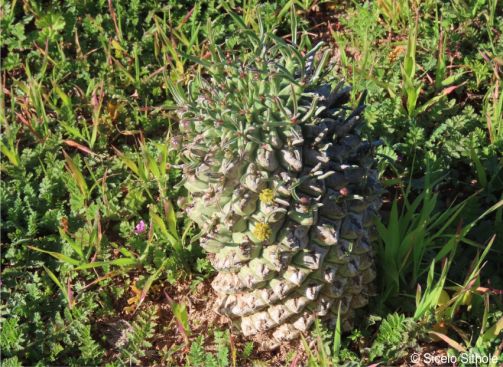
Growing Euphorbia schoenlandii
Grow
Euphorbias are relatively easy to grow and maintain, provided they are kept within their habitat preferences. They grow best in high temperatures. They prefer well-drained loamy soil which helps prevent the roots from drying up during extended dry periods. Watering should be based on the species native habitat, with species from moist areas preferring regular watering in summer while those from drier areas can manage with receiving water once a week or even less often than that. Euphorbia schoenlandii, comes from the winter-rainfall area and prefers to be kept dry during the summer months and needs water during the winter months.
Seed is the best way of propagating E. schoenlandii. Collected ripe fruits from the mother plant and keep them a paper bag left in a dry, warm place to dry out. Once ripe, the capsules explode, forcing the seeds out. The seed coat can then be filed a little and sowed in a tray filled with seedling medium. Seeds should be sown within a month of release and not be kept for more than two years, as older seeds tend to have reduced germination rate.
E. schoenlandii can also be propagated from cuttings. Cuttings are not common in this species because the plant is rarely branched. To make a cutting, a branch must be cut off cleanly where it is constricted at its base and the cut stem must be left to dry out for about a week before being planted into a rooting medium, which should contain river sand. After planting, it’s important to keep the cutting stable to avoid damaging the developing roots. Regular watering is required at this stage. However, overwatering the cuttings may cause the stems to rot if they remain overly damp. The cuttings should be kept in a well-ventilated environment.
References
- Jackson, W.P.U. 1990. Origins and meanings of names of South African plant genera. University of Cape Town Printing Department, Cape Town.
- Manning, J. & Goldblatt, P. 2012. Plants of the Greater Cape Floristic Region 1: the Core Cape Flora. Strelitzia 29. South African National Biodiversity Institute, Pretoria.
- Manning, J. 2009. Field guide to wild flowers of South Africa. Struik Nature, Cape Town.
- Mhlongo, N. 2022. Euphorbia umfoloziensis Peckover (Euphorbiaceae) PlantZAfrica. Online. https://pza.sanbi.org/euphorbia-umfoloziensis.
- Möller, A. & Becker, R.W. 2019. Field guide to the succulent euphorbias of southern Africa. Briza.
- Peter, C. 2018-08. Observation of Euphorbia schoenlandii. iNaturalist. Online. https://www.inaturalist.org/observations/16161867.
- Raimondo, D. 2007. Euphorbia schoenlandii Pax. National Assessment: Red List of South African Plants. https://redlist.sanbi.org/species.php?species=574-323.
- Snijman, D.A. (ed.). 2013. Plants of the Greater Cape Floristic Region 2: The Extra Cape Flora. Strelitzia 30. South African National Biodiversity Institute, Pretoria.
Credits
Sicelo Sithole & Mahlatse Malemone
Karoo Desert National Botanical Garden
September 2025
Acknowledgements: images of Euphorbia schoenlandii in habitat by Craig Peter.
Plant Attributes:
Plant Type: Succulent
SA Distribution: Western Cape
Soil type: Sandy, Loam
Flowering season: Autumn, Winter
PH: Acid, Neutral
Flower colour: Green, White, Yellow
Aspect: Full Sun
Gardening skill: Easy
Special Features:
Horticultural zones
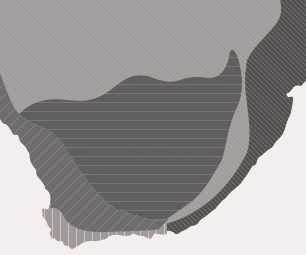







Rate this article
Article well written and informative
Rate this plant
Is this an interesting plant?
Login to add your Comment
Back to topNot registered yet? Click here to register.